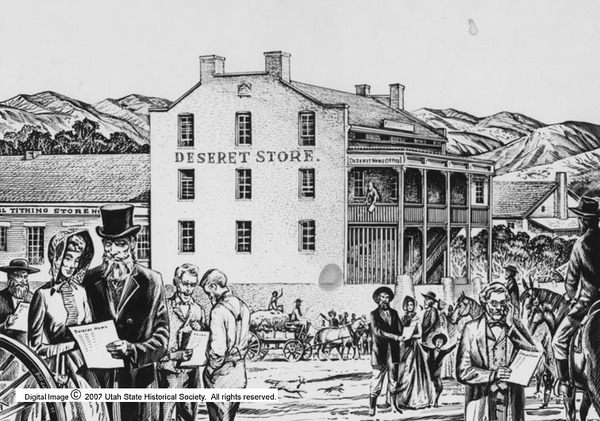Dublin Core
Title
Description
Much has been made of the early Mormons’ communal work ethic and the effective redistribution of resources within their communities. But how did they actually organize these efforts?
Life on the eastern edge of the Great Basin was not easy. When the Mormons arrived in 1847, they adapted to its harsh environment by forming communities and relying on one another to survive. Mormon leaders asked their congregations to “tithe” – or donate – ten percent of their income, property, and labor to the LDS Church every year. Church leaders gathered these resources in “Tithing Houses,” which were built in every settlement and used to manage and redistribute any accumulated surplus for the collective good.
Tithing Houses played a major role in the economic life of each community. Mormons relied on it to barter for the necessities they lacked. For example, if someone needed grain, they deposited a chicken. Or if they needed eggs, they deposited some grain. Or if they had neither chicken nor grain, they donated their own labor. Many new immigrants to Utah worked for the Tithing House before finding more permanent jobs in their communities.
Church leaders used the labor their congregations donated to the Tithing House to bring about massive public works projects such as constructing irrigation systems, grist mills, or other community buildings. The Salt Lake City Temple, for example, was built largely through labor coordinated through the Tithing House. When Mormons clashed with Indians, tithed labor was used to fortify community defenses. People in need could even borrow from and become indebted to the Tithing House. Communities took this debt so seriously that violence could break out if people tried to leave without paying it back.
Mormons cultivated this communal work ethic to survive the Great Basin and made it work through Tithing Houses. Part bank, part warehouse, and part employment exchange – it is hard to imagine how early Mormons would have survived – let alone thrived – without this small but effective institution.
Creator
Source
Image: Salt Lake City Tithing Office. Image shows the Salt Lake City tithing office. It was located on the corner of Main Street and South Temple where the Joseph Smith Memorial Building is now. In the early years of the LDS church, members would rarely pay their tithing (1/10 of total earnings) with money. More often, it was paid in livestock, dry goods, or a portion of their crop. This was all stored at the tithing office yards and distributed through the Deseret Store. The tithing yards also served as the first home of the Deseret News. Courtesy of Utah State Historical Society.
_______________
See Leonard J. Arrington, Great Basin Kingdom: An Economic History of the Latter-Day Saints, 1830-1900, Urbana: University of Illinois Press, 2005; Leonard J. Arringon, Feramorz Y. Fox, and Dean L. May, Building the City of God: Community and Cooperation among the Mormons, Urbana: University of Illinois Press, 1992; Leonard J. Arrington, “The Mormon Tithing House: A Frontier Business Institution,” The Business History Review, Vol. 28, No. 1 (Mar., 1954), pp. 24-58.

